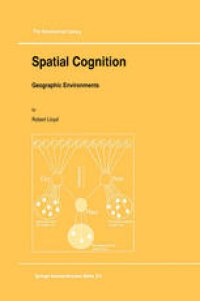
Ebook: Spatial Cognition: Geographic Environments
Author: Robert Lloyd (auth.)
- Tags: Geography (general), Artificial Intelligence (incl. Robotics), Methodology of the Social Sciences
- Series: The GeoJournal Library 39
- Year: 1997
- Publisher: Springer Netherlands
- Edition: 1
- Language: English
- pdf
10.2 Summary of Ideas ..................................................... 256 10.2.1 Spatial Behavior As Rules For Decision Making ................................... 258 10.2.2. Cognitive Mapping ......................................................................... 258 10.2.3. Storing Information ................................................. " ...................... 260 10.2.4. Searching ..................................................................................... 260 10.2.5. Learning ........................................................................................ 261 10.2.6. Judging Similarity .......................................................................... 261 10.2.7 Neural Geographic Information Science (NGIS) .................................... 262 REFERENCES ............................................... 265 INDEX ........................ .............. 279 ACKNOWLEDGEMENTS ................................... 287 x LIST OF TABLES Table 8.1: The types of similarity comparisons created for the experiment to determine the effect ofx as a first or second common or distinctive feature (Lloyd, Rostkowska-Covington, and Steinke 1996). Table 9.1: Data used to compute the gravity model using regression and a neural network. Data for all variables are scaled so that the highest value equals 0.9 and the lowest value equals 0.1. Table 9.2: Class means for 11 socio-economic and life-cycle variables for the Black, Integrated, and White classes. Table 9.3: Weights for neuron at row 5 and column 1 that learned the blue horizontal rectangle map symbol. LIST OF FIGURES Figure 1.1: Spatial cognition is a research area of interest for both geography and psychology. Both disciplines are interested in fundamental ideas related to encoding processes, internal representations, and decoding processes. Figure 1.2: The place names on this map of New Orleans depict the propositions used for navigation by local residents. A similar map appeared in the June 30, 1991, edition of The Times-Picayune.
This volume approaches geography as a cognitive science focusing on the processes used for learning and decision-making. This book argues that geographers need a theoretical understanding of how people process spatial information. How people store and use information they have acquired about environments is considered in a variety of geographic contexts. Cognitive theories and connectionist models are related to geographic problems to explain how spatial information is processed. The nature of cognitive maps, the processes used to encode them, and their systematic distortions are reviewed. A perception theory that explains the temporary tracking of environmental objects is considered as well as a theory that explains how verbal and visual information can be combined to create mental models of geographic environments in long-term memory. Other theories are considered that explain visual search processes used to find symbols or boundaries on maps. The processes used to learn spatial categories and prototypes, to create abstract knowledge in basic-level categories, and to judge the similarity of objects are also addressed. Neural networks are discussed throughout the book and used to model learning and classification processes.
Audience: This book is directed at researchers and students in geography/social geography, psychology and cognitive science interested in spatial cognition.
This volume approaches geography as a cognitive science focusing on the processes used for learning and decision-making. This book argues that geographers need a theoretical understanding of how people process spatial information. How people store and use information they have acquired about environments is considered in a variety of geographic contexts. Cognitive theories and connectionist models are related to geographic problems to explain how spatial information is processed. The nature of cognitive maps, the processes used to encode them, and their systematic distortions are reviewed. A perception theory that explains the temporary tracking of environmental objects is considered as well as a theory that explains how verbal and visual information can be combined to create mental models of geographic environments in long-term memory. Other theories are considered that explain visual search processes used to find symbols or boundaries on maps. The processes used to learn spatial categories and prototypes, to create abstract knowledge in basic-level categories, and to judge the similarity of objects are also addressed. Neural networks are discussed throughout the book and used to model learning and classification processes.
Audience: This book is directed at researchers and students in geography/social geography, psychology and cognitive science interested in spatial cognition.
Content:
Front Matter....Pages i-xxiii
Geography and Cognitive Science....Pages 1-24
A Connectionist Approach to Spatial Cognition....Pages 25-43
Cognitive Maps....Pages 44-69
Storing Spatial Information in Memory....Pages 70-92
Spatial Search Processes....Pages 93-118
Learning Geographic Information....Pages 119-150
Spatial Prototypes....Pages 151-184
Similarity....Pages 185-215
Neural Network Applications....Pages 216-255
Conclusions....Pages 256-264
Back Matter....Pages 265-287
This volume approaches geography as a cognitive science focusing on the processes used for learning and decision-making. This book argues that geographers need a theoretical understanding of how people process spatial information. How people store and use information they have acquired about environments is considered in a variety of geographic contexts. Cognitive theories and connectionist models are related to geographic problems to explain how spatial information is processed. The nature of cognitive maps, the processes used to encode them, and their systematic distortions are reviewed. A perception theory that explains the temporary tracking of environmental objects is considered as well as a theory that explains how verbal and visual information can be combined to create mental models of geographic environments in long-term memory. Other theories are considered that explain visual search processes used to find symbols or boundaries on maps. The processes used to learn spatial categories and prototypes, to create abstract knowledge in basic-level categories, and to judge the similarity of objects are also addressed. Neural networks are discussed throughout the book and used to model learning and classification processes.
Audience: This book is directed at researchers and students in geography/social geography, psychology and cognitive science interested in spatial cognition.
Content:
Front Matter....Pages i-xxiii
Geography and Cognitive Science....Pages 1-24
A Connectionist Approach to Spatial Cognition....Pages 25-43
Cognitive Maps....Pages 44-69
Storing Spatial Information in Memory....Pages 70-92
Spatial Search Processes....Pages 93-118
Learning Geographic Information....Pages 119-150
Spatial Prototypes....Pages 151-184
Similarity....Pages 185-215
Neural Network Applications....Pages 216-255
Conclusions....Pages 256-264
Back Matter....Pages 265-287
....